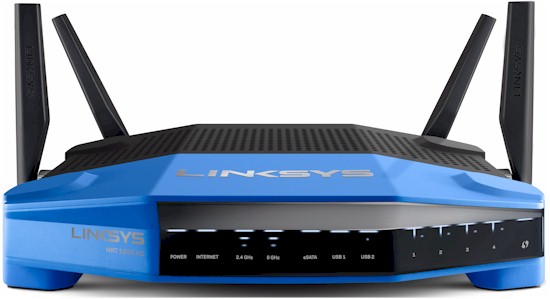
| At a glance | |
|---|---|
| Product | Linksys AC1900 Dual Band Wireless Router (WRT1900AC) [Website] |
| Summary | Marvell-based AC1900 class router with Gigabit Ethernet ports and USB 3.0 / eSATA storage sharing |
| Pros | • Establishes a new high in router storage sharing performance • Supports non WDS bridging and repeating |
| Cons | • Smaller feature set than other top-end routers |
Typical Price: $80 Buy From Amazon
Introduction
In the WRT1900AC review, I promised to come back and beat on Linksys’ new top-of-line router to dig a little deeper. I ran four investigations:
- Checked 2.4 GHz 600 Mbps link rate performance
- Checked for interaction between storage and wireless performance
- Stress tested with simultaneous high loads on both radios and wired routing
- Checked for compatibility with various clients, including N
Let’s hop right to it.
2.4 GHz 600 Mbps Link Rate Performance
Since I have had mixed results with ASUS’ PCE-AC68 AC1900 client, I used a second WRT1900AC in wireless bridge mode. It was parked in the same room under 10 feet away from the WRT1900AC acting as a router. The main router’s 2.4 GHz radio was set to Auto mode, Channel 6 and had WPA2/AES security enabled.
All I had to do on the Bridge router was select the Wireless Bridge mode and enter the SSID and WPA2 key of the main router. As noted in the original review, neither WRT1900AC provides any indication of bridge link rate, signal level or traffic. So I don’t really know whether these results represent 256 QAM modulation rates (289 Mbps in 20 MHz mode and 600 Mbps with 40 MHz bandwidth) and I remain a skeptic of the value of 256 QAM in 2.4 GHz.
The first IxChariot screenshot compares downlink throughput with the router forced to 20 MHz mode and Auto mode. Looks like something is working because the auto mode throughput is about 2X the 20 MHz mode’s! But I went back and checked the 20 MHz mode results from our standard tests using the ASUS PCE-AC66 AC1750 class client and found 123 Mbps, which is actually a bit higher than measured in this test.
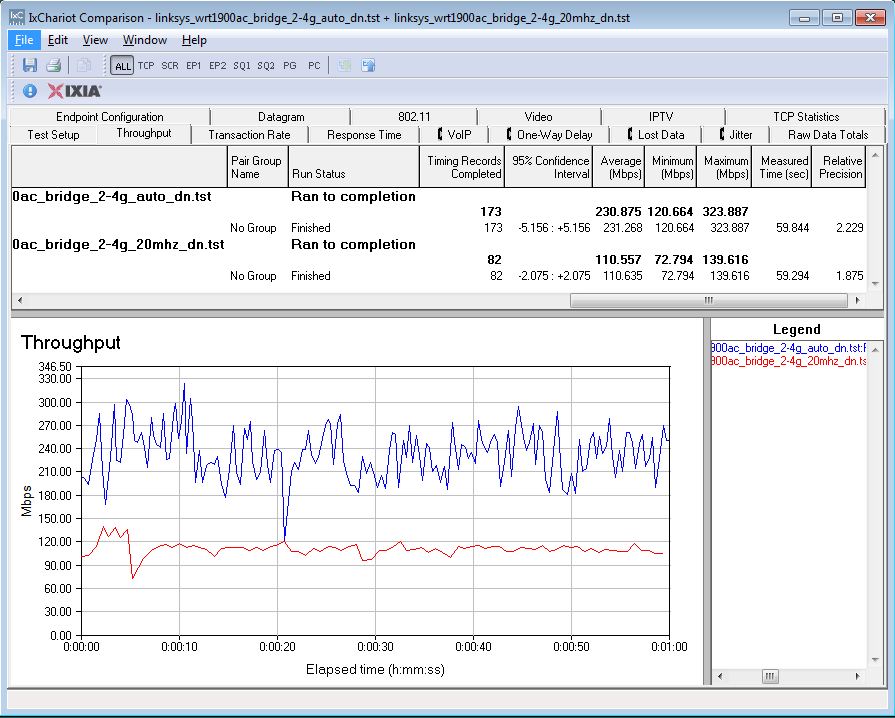
Linksys WRT1900AC 2.4 GHz bridge throughput comparison – downlink
Here’s the uplink version of the plot. Once again, Auto mode provides around double the throughput. I measured 116 Mbps using the standard PCE-AC66 adapter, so, again, the 20 MHz mode results don’t represent any real gain in performance.
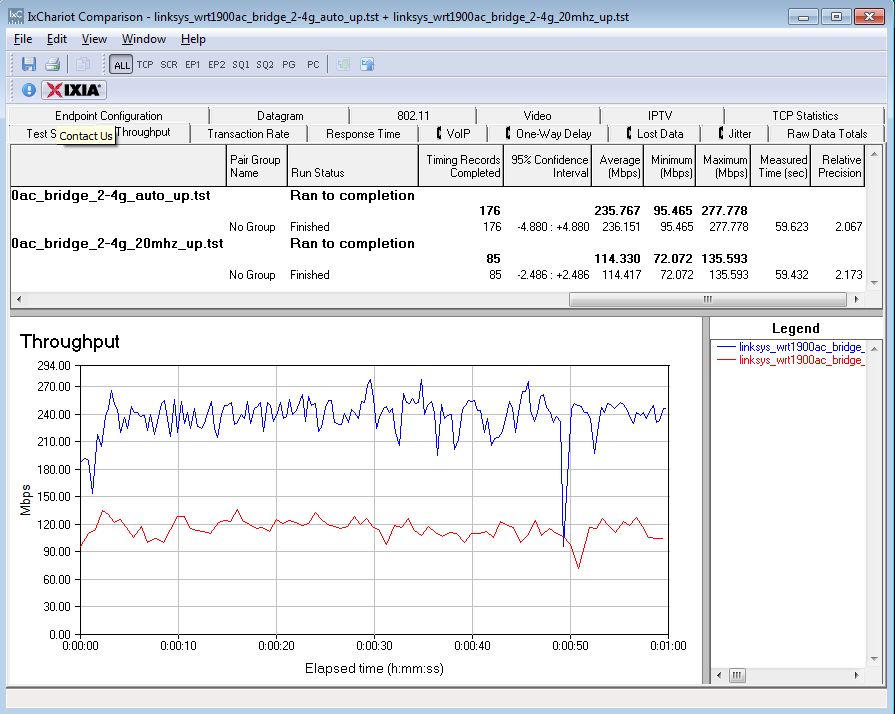
Linksys WRT1900AC 2.4 GHz bridge throughput comparison – uplink
I also ran simultaneous up and downlink tests in each mode to check for total throughput. Here is 20 MHz mode. Total throughput is only a tad more than best-case unidirectional throughput because for some reason downlink throughput was significantly lower than its unidirectional test results. The 159 Mbps I measured using my standard adapter is again higher than the results below.
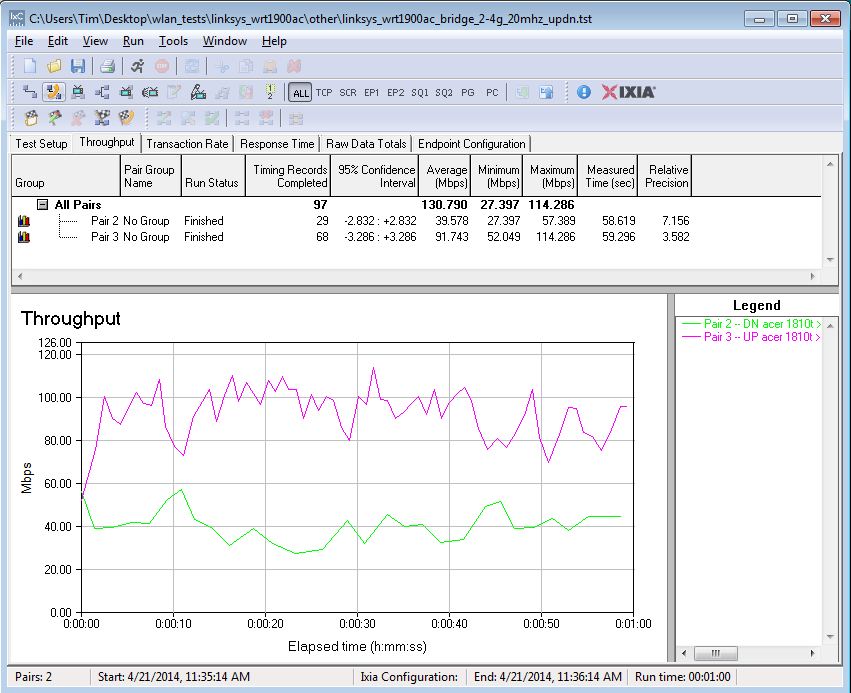
Linksys WRT1900AC 2.4 GHz bridge throughput 20 MHz mode – simultaneous up/downlink
Total Auto mode throughput was much better, although downlink throughput again dropped below its unidirectional value. Since we don’t test in 40 MHz mode for my standard benchmarks, there are no results to compare here.
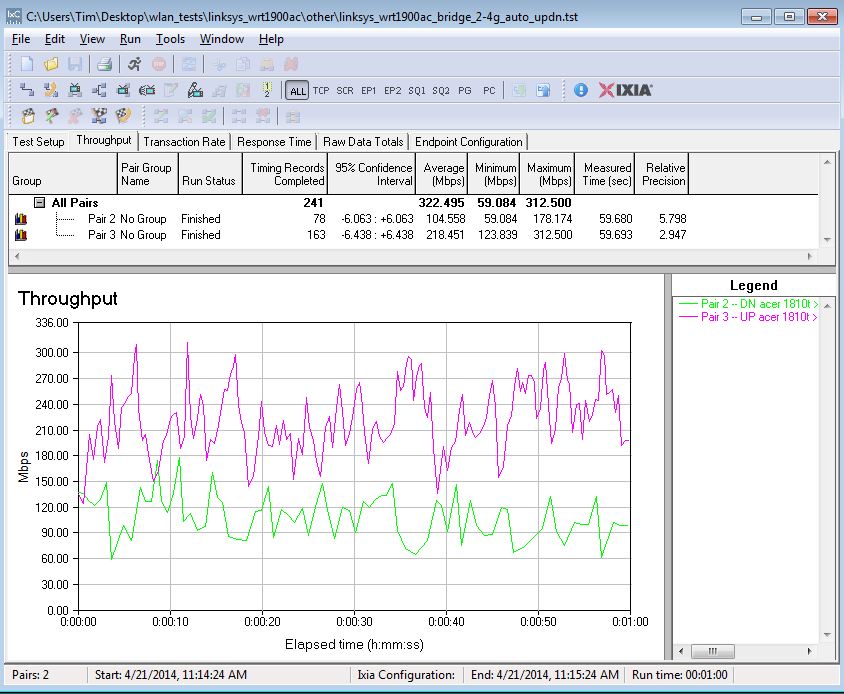
Linksys WRT1900AC 2.4 GHz bridge throughput Auto mode – simultaneous up/downlink
Remember these are results with router and bridge in the same room. High link rate throughput tends to drop quickly with signal levels, so don’t count on 200+ Mbps throughput in real-world use.
Storage / WLAN Interaction
Routers with USB 3.0 ports must take care with internal design and shielding to prevent impairing 2.4 GHz radio performance (and vice-versa) when both are active. Since I was running these tests in the back lab where the test chamber is and not in my office, I had to use a different computer to copy files. So I pressed my relatively new Acer Aspire S7 running Win 8.1 into service. The S7 uses two 60 GB Kingston SSD’s in RAID 0, so it was perfectly capable of keeping up with the WRT1900AC’s previously-measured 75 MB/s filecopy performance.
I set up the WD Passport USB 3.0 drive used in the first round of storage testing and used the single Backup.bkf file from the Intel NASPT filecopy test benchmarks. This is single 1.15 GB Windows backup file vs. the 4+ GB folder of files normally used for file transfer tests, which made it easier to eyeball performance using the throughput plot in the enhanced Windows 8 filecopy window.
The first screenshot below shows the drag-and-drop from the S7 to the WD drive shared by the WRT1900AC, i.e. write, with expected ~75 MB/s throughput.
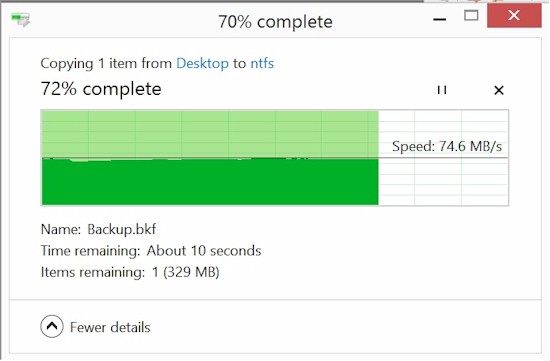
Filecopy to USB 3.0 drive – no WLAN active
Then I started IxChariot downlink streams on both 2.4 and 5 GHz radios, with no storage activity, to get the baseline shown below.
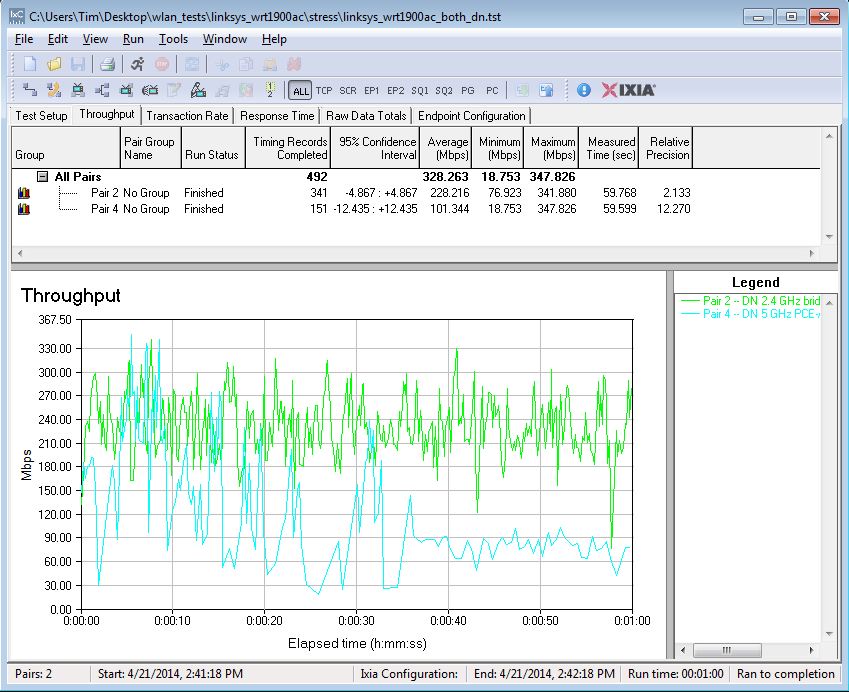
Wireless dual band downlink – no filecopy active
I then started the same WLAN activity again, waited until the 30 second point, then started the drag-and-drop filecopy. Storage performance dropped by about 20 MB/s or 28% as shown in the Win 8 filecopy window screenshot.
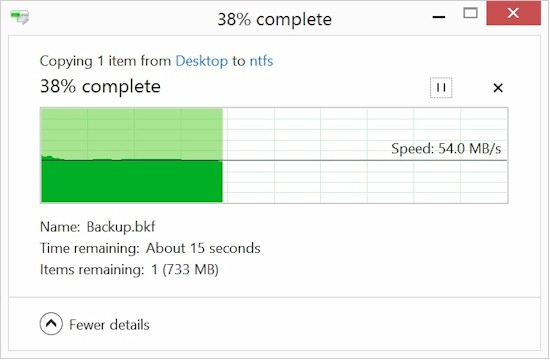
Filecopy to USB 3.0 drive – WLAN active
Average 2.4 GHz throughput also dropped 56 Mbps (228 to 172 Mbps) or 25%.
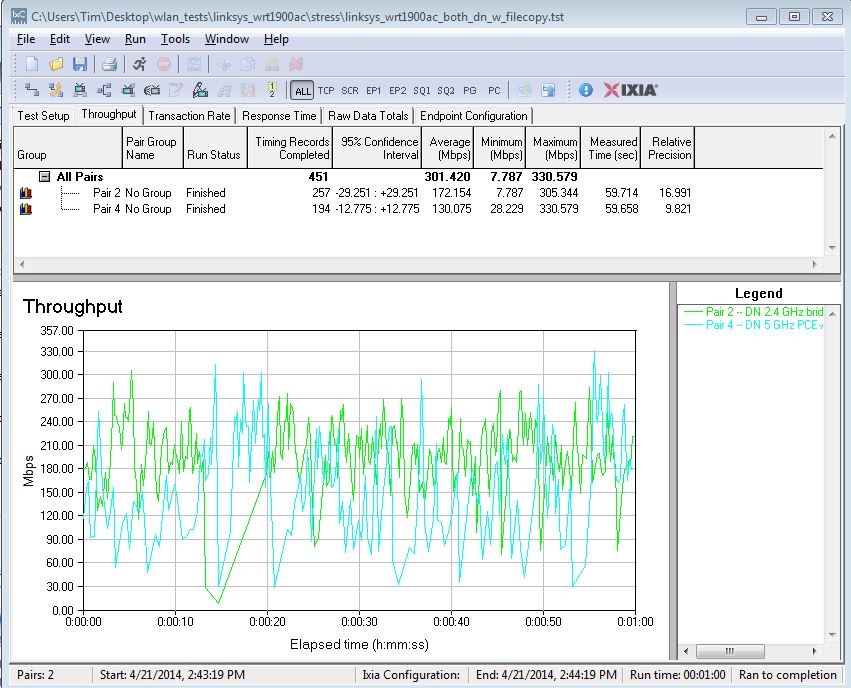
Wireless dual band downlink – filecopy active
This being said, results could vary somewhat. So I tried another simple test, this time starting the filecopy then starting and stopping 2.4 GHz wireless activity. The plot clearly shows a decline in filecopy throughput when the WLAN is active. Still, 50 MB/s file copy performance isn’t too shabby with 2.4 GHz steadily blasting away with over 170 Mbps of throughput.
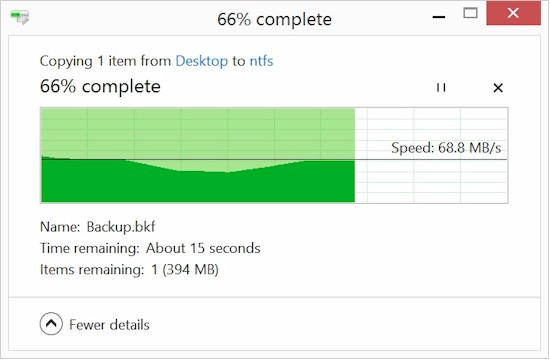
Filecopy to USB 3.0 drive – WLAN start / stop
Stress Test
To check for interaction between wired routing and wireless performance, I ran a test similar to one I’ve run before. I set up four IxChariot throughput scripts as follows:
- LAN to WAN Wired Routing (limited to 300 Mbps send rate)
- WAN to LAN Wired Routing (limited to 300 Mbps send rate)
- 5 GHz Wireless Downlink (ASUS PCE-AC66 AC1750 class client linked at 1.3 Mbps)
- 2.4 GHz Wireless Downlink (Intel Centrino Ultimate N N900 class client client linked at 217 Mbps)
I limited wired routing throughput mainly to smooth out the plots and make it easier to see changes in wireless performance. The plot starts the 5 GHz traffic first, followed by 2.4 GHz, WAN to LAN and finally LAN to WAN at one minute intervals. Due to the high variation in 5 GHz throughput, it’s tough to tell exactly how much throughput falls when WAN to LAN wired routing starts. But it seems like at least 40 Mbps.
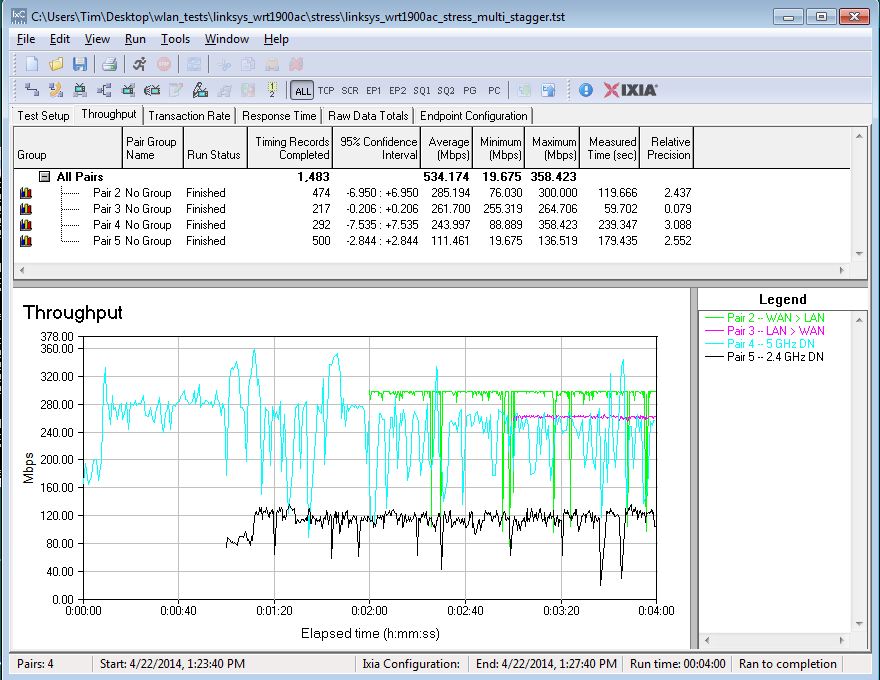
Linksys WRT1900AC wired and wireless stress test
It seems like the start of 2.4 GHz traffic negatively impacts 5 GHz throughput first, however. But none of the wired routing traffic seems to affect 2.4 GHz throughput at all. Of course, 2.4 GHz throughput is around half 5 GHz’s. In all, this isn’t a bad showing for the WRT1900AC and seems like the 1.2 GHz Marvell Armada processor is doing a decent job of keeping everything running at a high clip.
Note I didn’t throw storage into this too, since we already saw it reduces 2.4 GHz throughput around 25% when the USB 3.0 port is used.
Interoperability
A few folks in the forums asked about the WRT1900AC’s compatibility with N devices, since that has been a problem for some NETGEAR R7000 users. So I gathered up an assortment of devices lying around the SNB office, gave each a one minute test and summarized the results in Table 1.
| Device | OS | Chipset | Class | Tested Link Rate (Mbps) | 2.4 GHz Throughput (Mbps) | 5 GHz Throughput (Mbps) | Comment | |||
|---|---|---|---|---|---|---|---|---|---|---|
| 2.4 | 5 | Down | Up | Down | Up | |||||
| Chromo 7 | Android | ? | N150 | 78 | – | 47.8 | 43.6 | – | – | Very well behaved in general |
| Apple iPad2 | iOS 7.1 | Broadcom BCM43291 | N150 | N/A | N/A | 26.9 | 13.2 | 27.0 | 13.6 | Low performance, especially uplink |
| Apple iPhone 4s | iOS 6.1.3 | Broadcom BCM4330 | N150 | N/A | N/A | – | – | – | – | Connected, but would not ping or run IxChariot |
| Google Nexus 7 | Android 4.4.2 | Broadcom BCM4330 | N150 | 65 | – | 34.1 | 27.4 | – | – | High downward throughput spikes |
| Acer Aspire S7-392 | Windows 8.1 | Intel Wireless-N 7260 | N600 | 144 | 300 | 23.7 | 76.6 | 76.1 | 153.8 | Downlink slower than uplink on both bands. High 5 GHz variation |
| Lenovo x220i | Windows 7 SP1 | Intel Centrino Ultimate N 6300 | N900 | 217 | 450 | 90.8 | 101.0 | 110.8 | 133.8 | Better behaved than N 7260. |
| Moto X | Android 4.2.2 | QCA WCN3680 | AC580 | 86 | 78 | 48.4 | 35.4 | 52.8 | 92.8 | High downward throughput spikes in 2.4 GHz. 5 GHz did not link at full AC rate. |
| Linksys AE6000 | Windows 7 on Lenovo x220i | MediaTek MT7610U | AC580 | 86.5 | 433 | 46.0 | 49.1 | 221.5 | 153.3 | Better behaved than MotoX |
| NETGEAR A6200 | Windows 7 on Lenovo x220i | Broadcom BCM43526 | AC1200 | 144 | 866.5 | 89.3 | 66.3 | 208.4 | 177.8 | Both bands well behaved |
| ASUS PCE-AC66 | Windows 7 on Dell Optiplex 790 SFF | Broadcom BCM4360 | AC1750 | 216.5 | 1300 | 111.3 | 116.5 | 209.6 | 323.2 | Good performance, but high variation on both bands. |
Table 1: Linksys WRT1900AC Interoperability Test Summary
The good news is that everything I tried was able to connect to the WRT1900AC just fine. But the iPhone 4s was the only device that could not be pinged or run the IxChariot test. Note that the same BCM4330 chipset in the Android-powered Google Nexus 7 tablet was able to run the test. Also note the Moto X, which has a 1×1 AC580 class radio failed to link at the 433 Mbps rate it should have in the 5 GHz test.
I was least impressed with the Intel Wireless-N 7260’s performance, which suffered from low downlink and disconnected on one of the test runs. IxChariot plots for each test are in the gallery. You can get a better feel for each clients performance by clicking through the IxChariot plots.
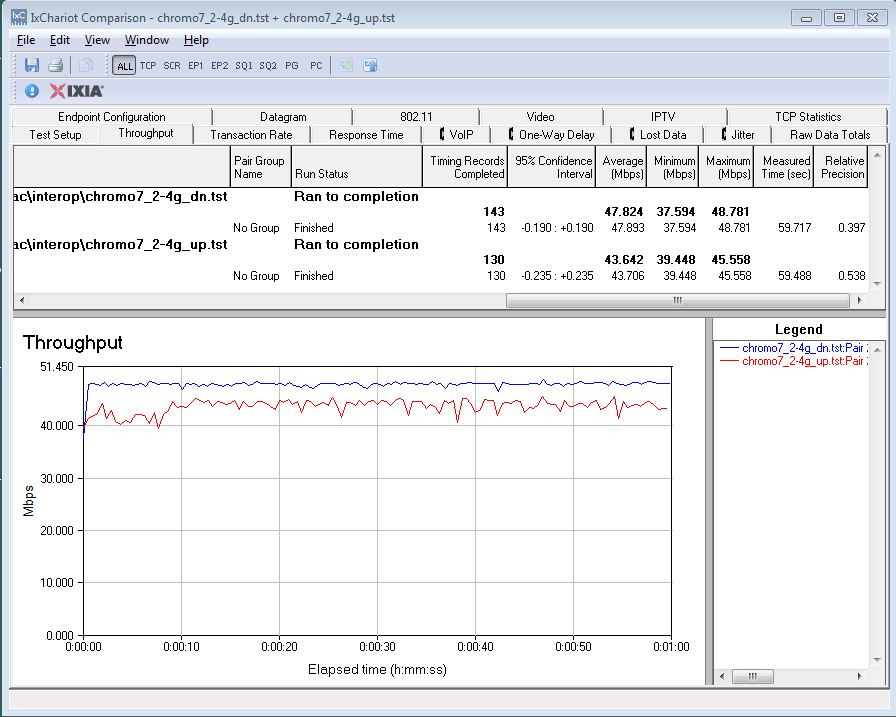
Chromo 7 Android tablet throughput. Unknown chipset
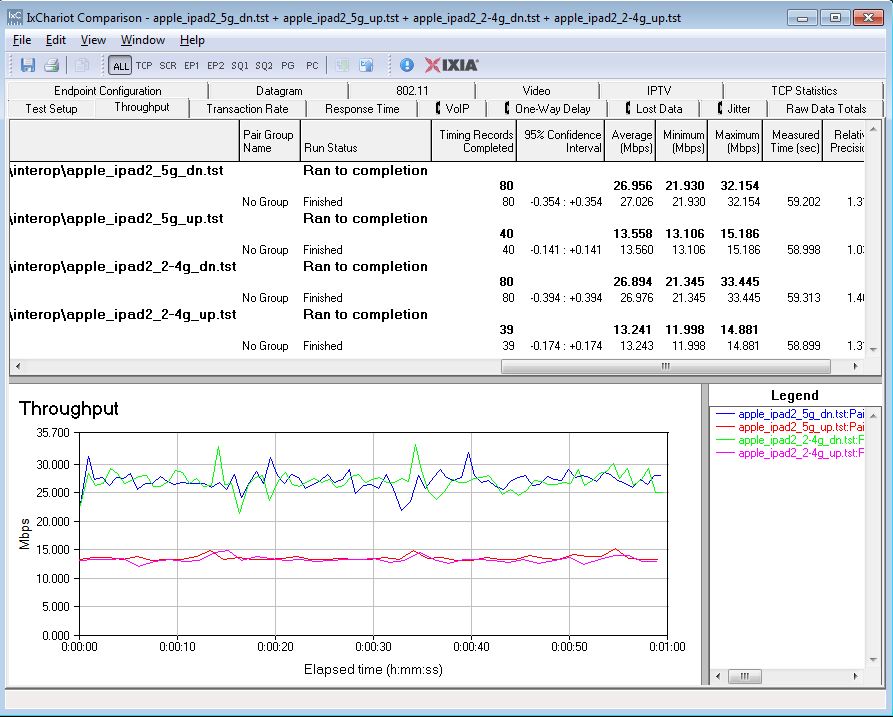
Apple iPad 2 throughput. Broadcom BCM43291 chipset
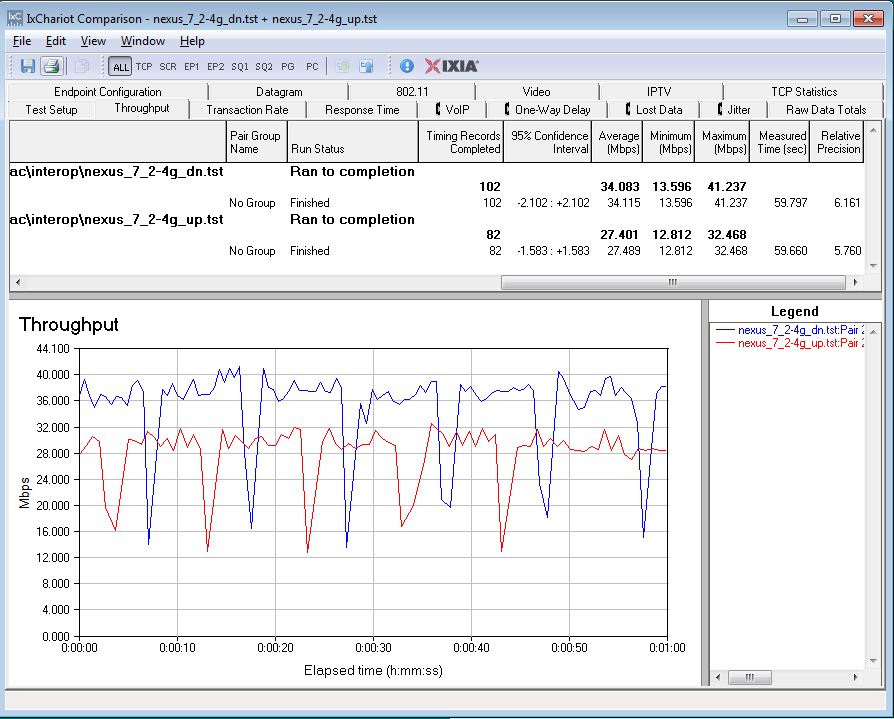
Google Nexus 7 (original) throughput. Broadcom BCM4330. Same chipset that did not work in iPhone 4s.
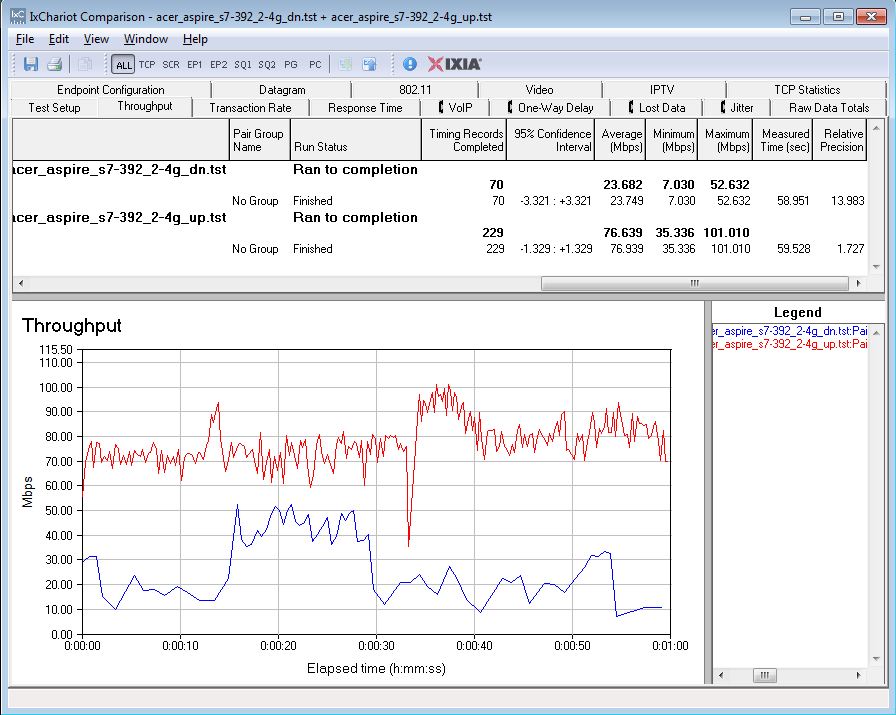
Acer Aspire S7-392 2.4 GHz throughput. Intel Wireless-N 7260 chipset
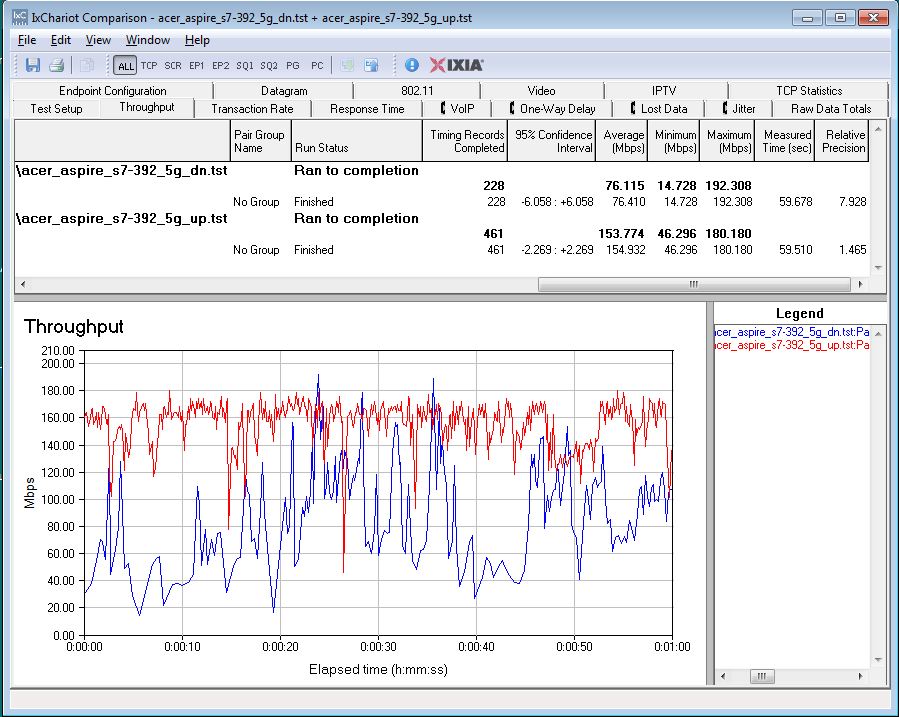
Acer Aspire S7-392 5 GHz throughput. Intel Wireless-N 7260 chipset
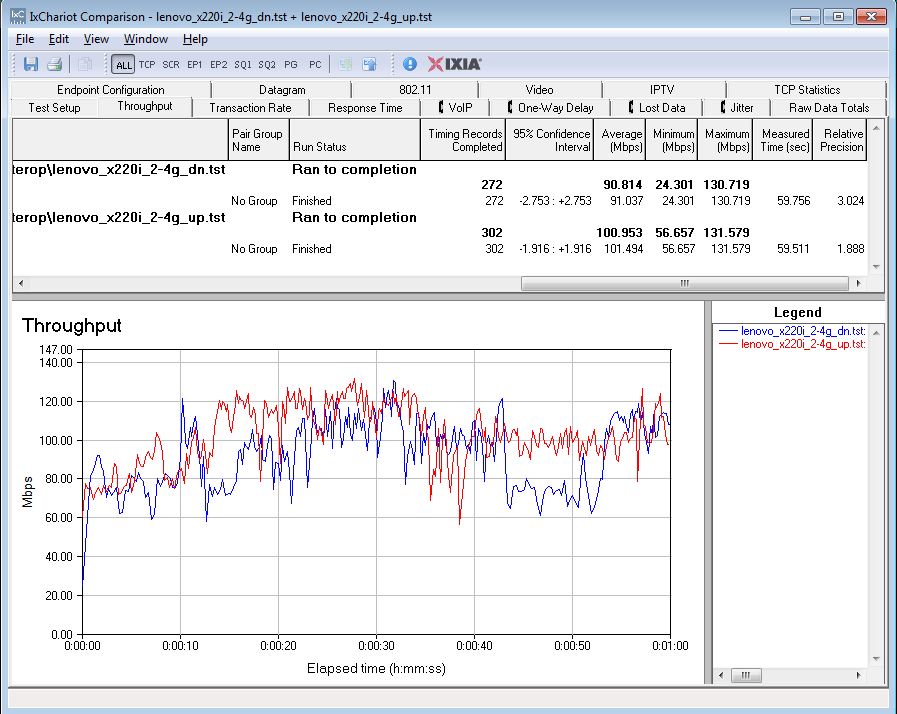
Lenovo x220i 2.4 GHz throughput. Intel Centrino Ultimate N 6300 chipset
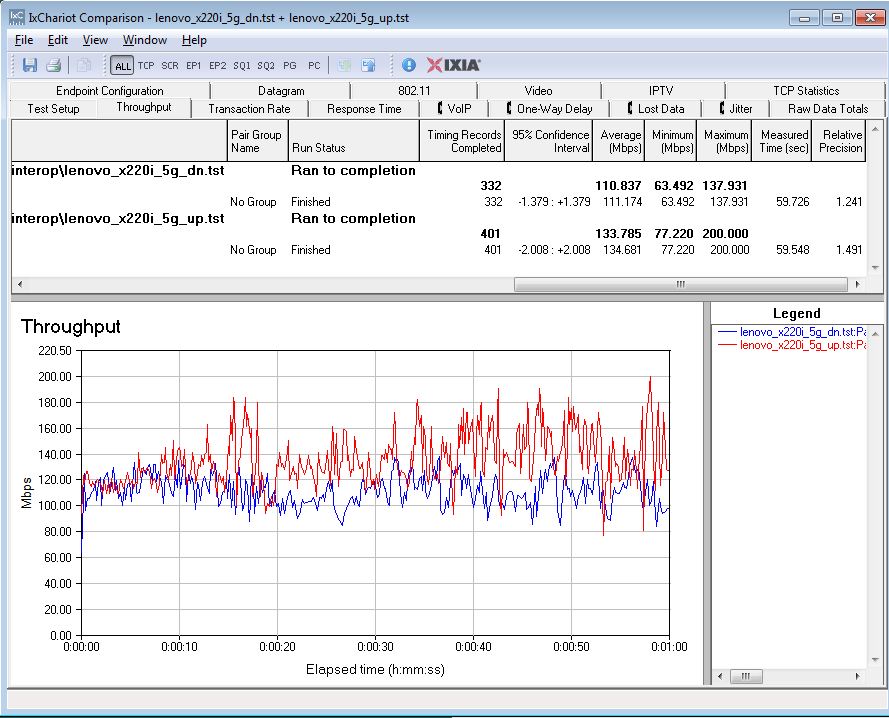
Lenovo x220i 5 GHz throughput. Intel Centrino Ultimate N 6300 chipset
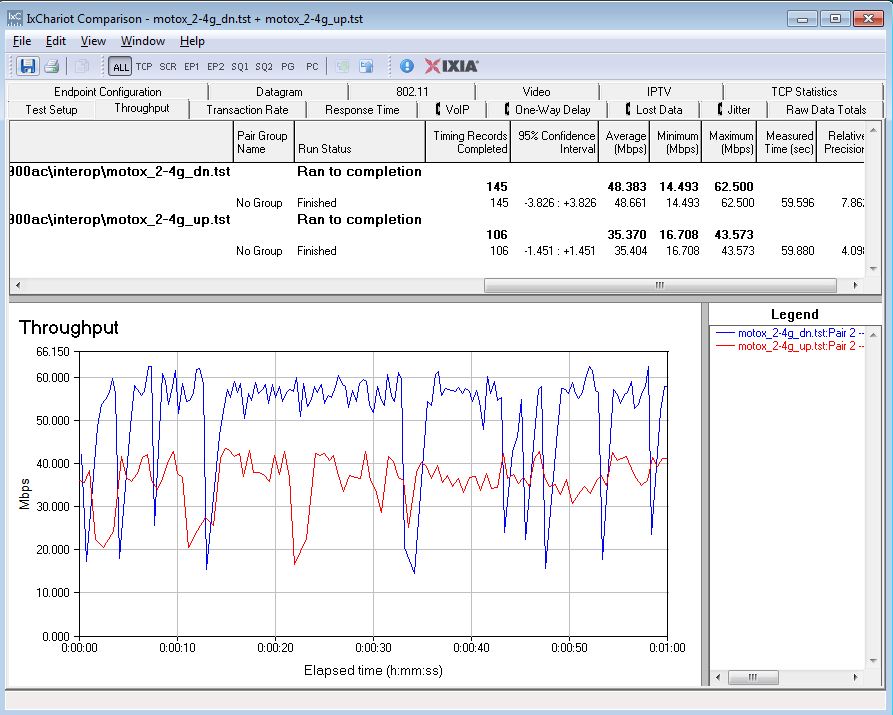
Moto X Android phone 2.4 GHz throughput. QCA WCN3680 chipset
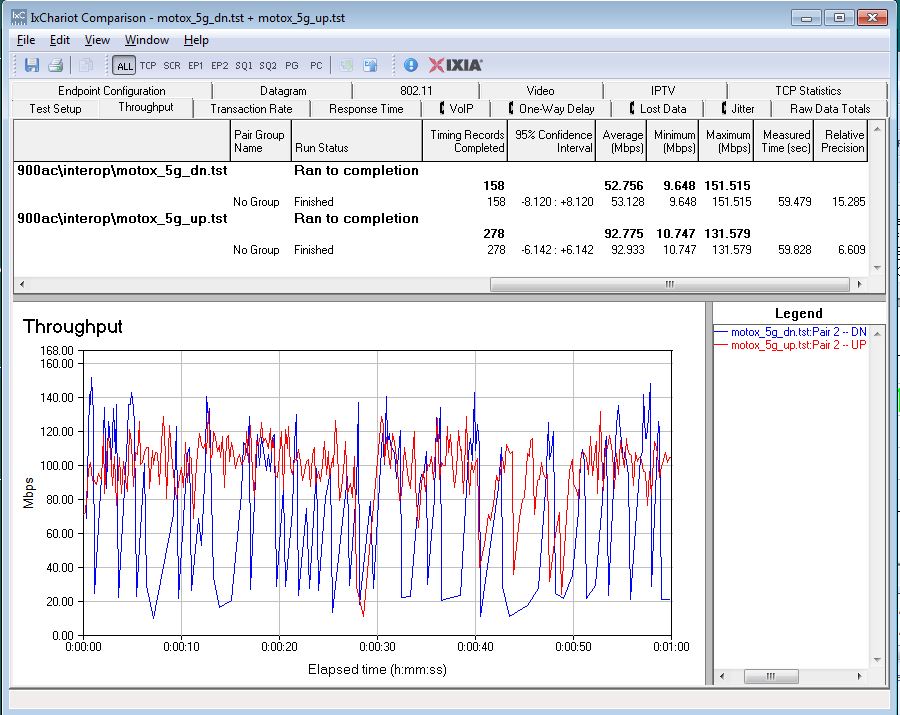
Moto X Android phone 5GHz throughput. QCA WCN3680 chipset
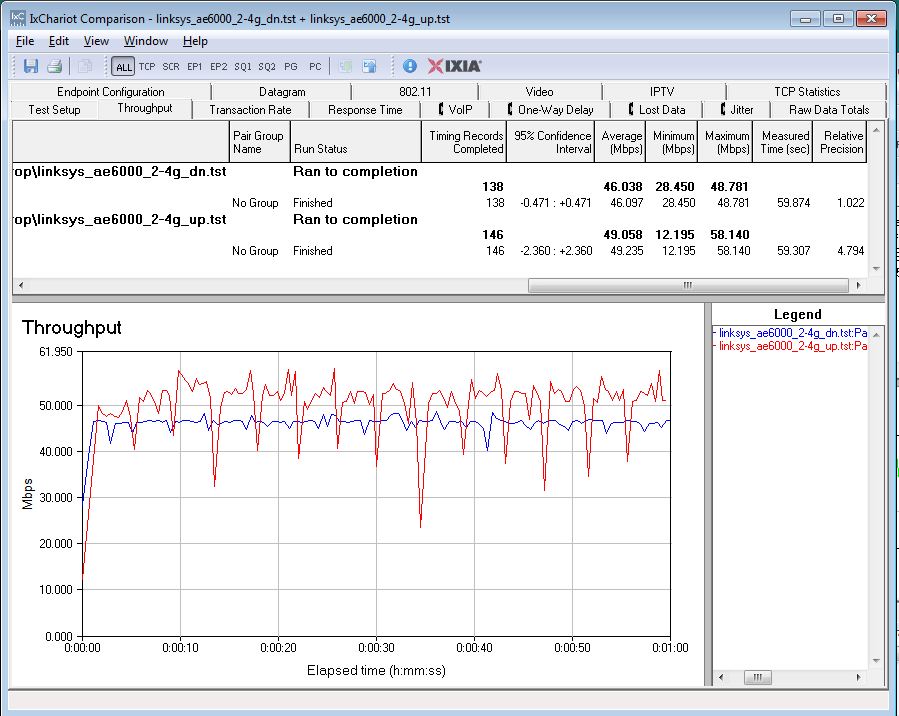
Linksys AE6000 USB adapter 2.4 GHz throughput. MediaTek MT7610U chipset
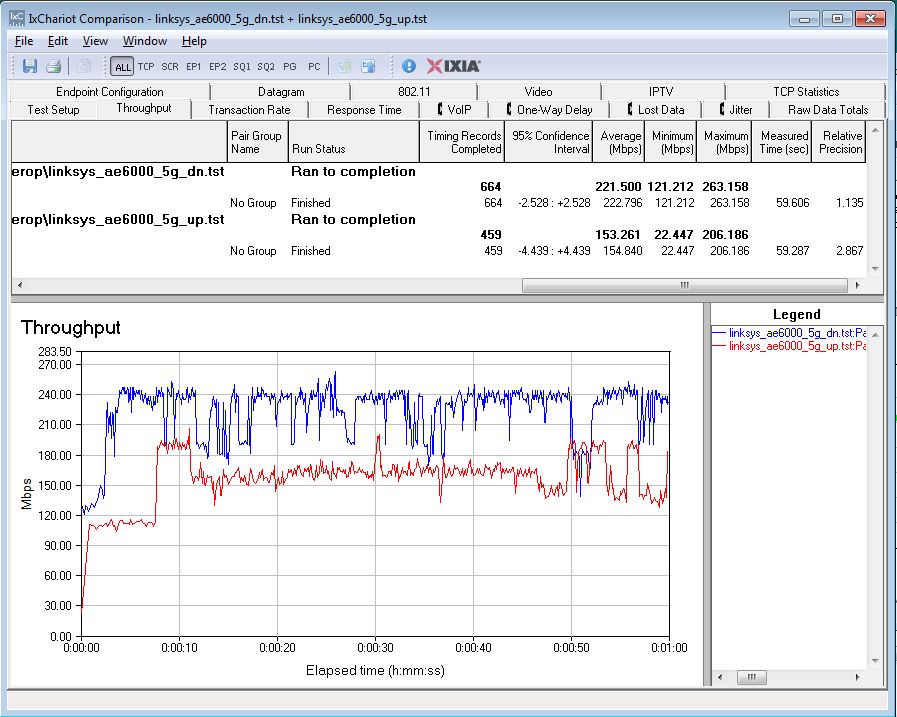
Linksys AE6000 USB adapter 5 GHz throughput. MediaTek MT7610U chipset
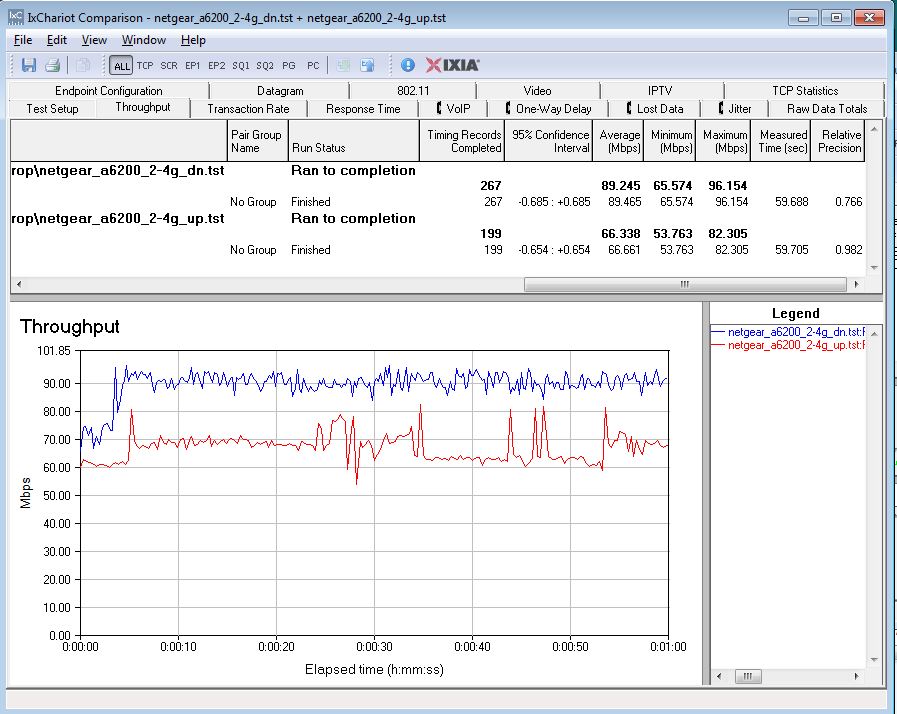
NETGEAR A6200 USB adapter 2.4 GHz throughput. Broadcom BCM43526 chipset
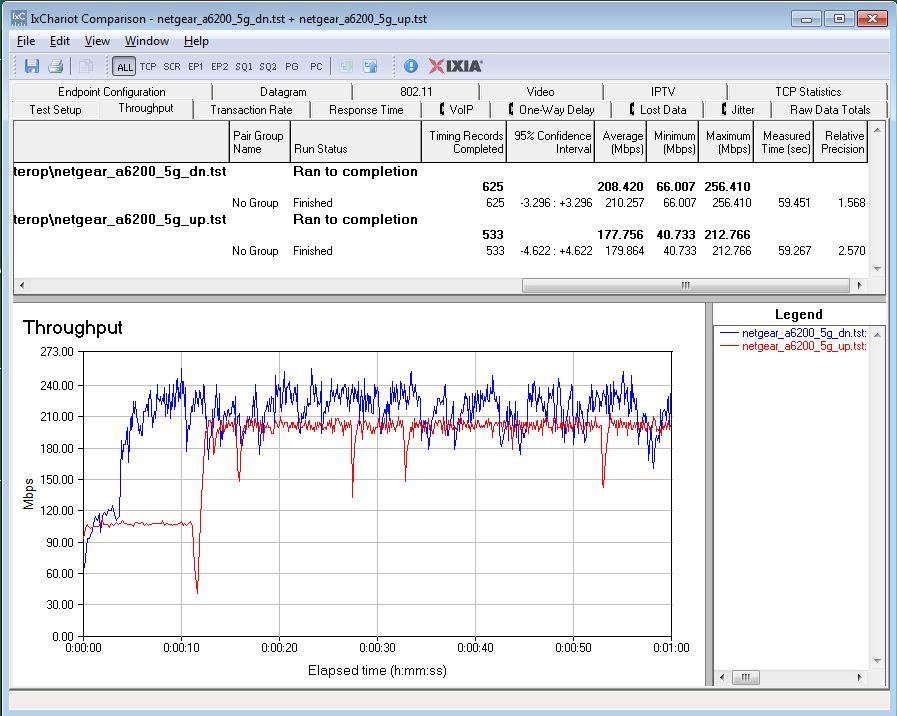
NETGEAR A6200 USB adapter 5 GHz throughput. Broadcom BCM43526 chipset
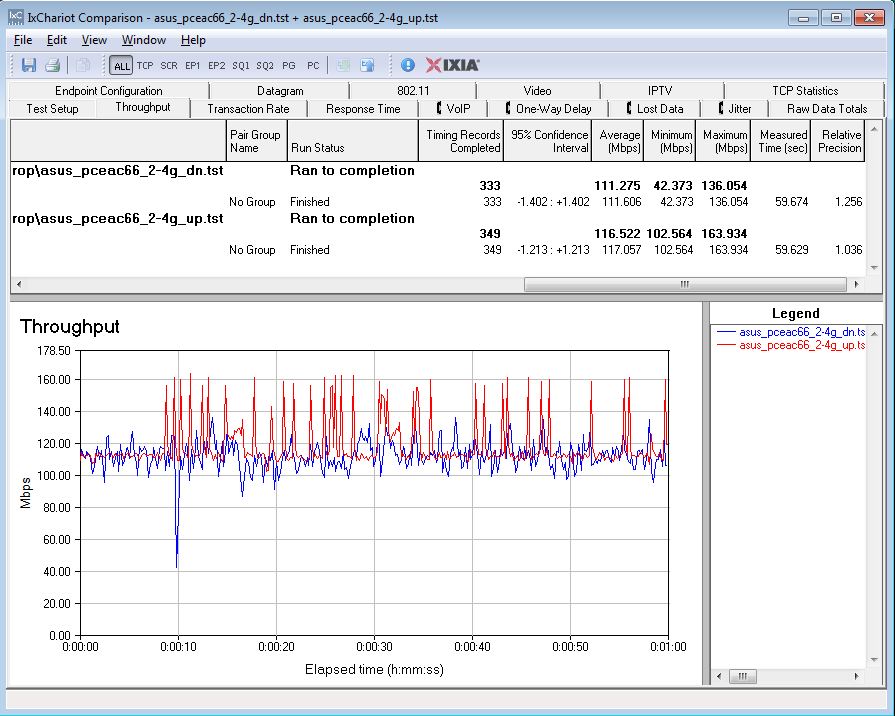
ASUS PCE-AC66 PCIe adapter 2.4 GHz throughput. Broadcom BCM4360 chipset
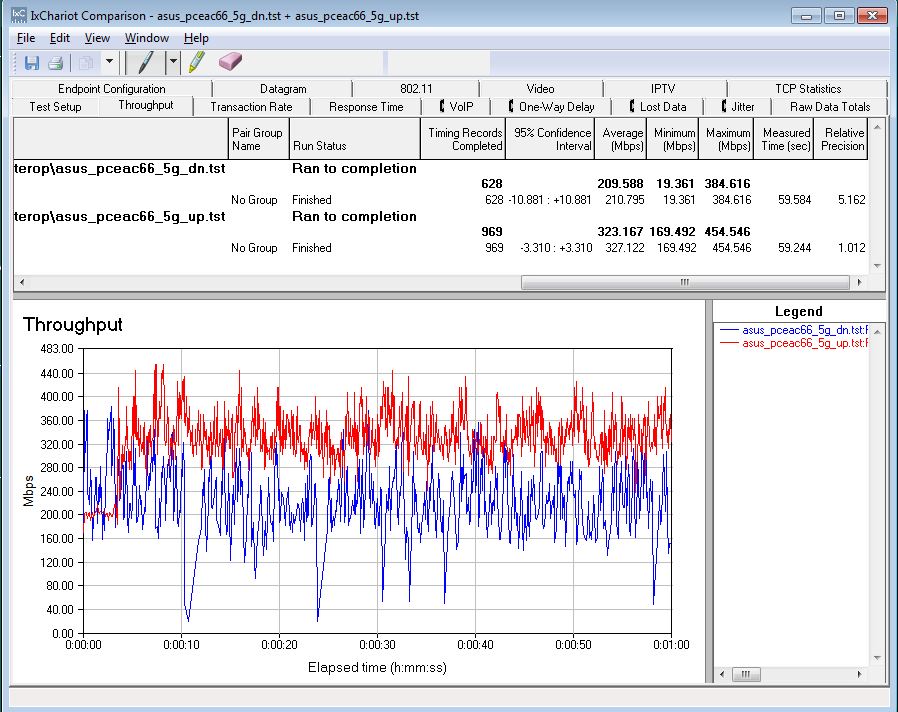
ASUS PCE-AC66 PCIe adapter 5 GHz throughput. Broadcom BCM4360 chipset
Closing Thoughts
I was going to include the results of another test running a mix of wireless client types plus wired routing, with a target of 24 hours. So far, however, the test has not been able to run more than five minutes or so without a client disconnect. But I think the problem is in my test setup, not the WRT1900AC. So that will have to wait for another time.
The main takeaway from these additional tests is that the WRT1900AC seems to have enough processing power to handle heavy simultaneous wired routing, wireless on both bands and storage activity. But, to no surprise, client compatibility still needs some work.
So my botton line remains the same as in the original review. If you’re unhappy with either ASUS’ RT-AC68U or NETGEAR’s R7000 Nighthawk and have the time, money and inclination, you might as well give the WRT1900AC a shot and see if it can make you happier.
